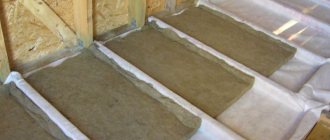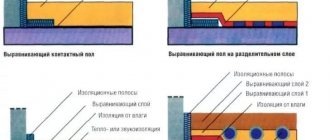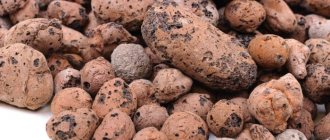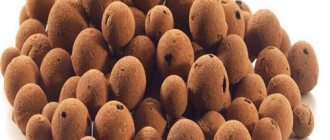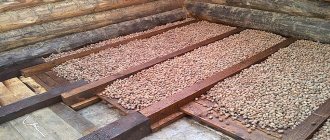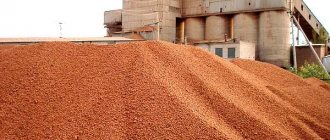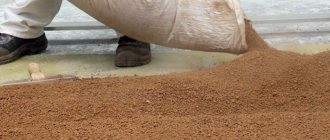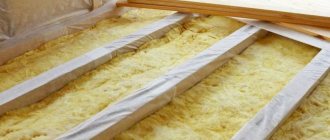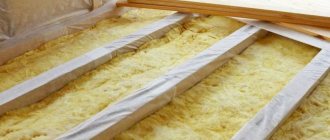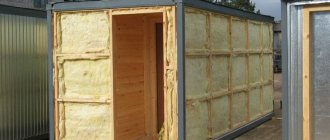Insulation of concrete floor
If you have a concrete floor in the steam room and washing room, then at the beginning of construction the foundation for the washing room or steam room is poured, on top of which a concrete floor slab is laid.
Next, they put in waterproofing and insulation, after which they make a screed with a special reinforcing mesh. Now the heated floor system is laid, on top of which the tiles are glued.
Video:
Since the ceramic coating is usually cold and rather slippery, a removable wooden grid is placed on top of it, which is taken out of the bathhouse (washing room) for drying after each use.
To insulate a concrete floor with your own hands, perlite is most often used; expanded clay or glass wool are also used.
The layer of insulating material must be between two concrete layers.
Perlite insulation
If you work with perlite, be sure to close the door to the room so that it does not fly apart.
Perlite is excellent for thermal insulation of such rooms, as it has low thermal conductivity.
Mix the insulation with water 2 to 1, then add cement to the mixture and mix thoroughly. Now add 0.5 liters of water and a bucket of insulation so that no water is released in your solution.
When the insulating composition is ready, apply a thin layer of it to the concrete slab and leave to dry for about a week.
The next layer of concrete is applied to the dry surface. This way you will get reliable thermal insulation that will last for many years.
Foam insulation
You can insulate a concrete bathhouse with polystyrene foam, penoplex or expanded polystyrene - one of the simplest and most economical ways.
This material is easy to process and has a low mass; in addition, it does not absorb moisture and does not rot, and is also environmentally friendly and safe for health.
Insulation with extruded polystyrene foam can be done without special skills and tools.
Practical weightless slabs do not weigh down the already heavy concrete floors and foundation.
Most often, foam insulation is done in two layers, and the joints between the sheets are sealed with polyurethane foam or scraps of the same material. The layer thickness can be from 10 to 25 cm.
A reinforced screed is laid on top of the foam, and when it is completely dry, it is covered with tiles on top.
You should know that before insulating with foam plastic, a layer of waterproofing must be laid on the concrete base to extend the service life of the insulation.
Insulation with expanded clay
Expanded clay insulation is also quite often used in the construction of baths. This is a porous material that is lightweight and has high thermal insulation properties.
The thickness of the material layer depends on the loads to which your floor will be subjected.
Beacons are laid on the concrete base using a solution, along which the screed will then be leveled. When the solution dries, the base is covered with expanded clay.
It is important that the expanded clay layer is laid level, without slopes or other defects. Next, the expanded clay is filled with a solution to seal the thermal insulation. Cement can be reinforced with reinforcing mesh
This floor will be at its strongest a month after installation.
Cement can be reinforced with reinforcing mesh. This floor will be at its strongest a month after installation.
How to insulate the floor in a bathhouse
Historically, the least attention was paid to the floors in bathhouses.
This was explained by the fact that there was no centralized sewage system, and all the water flowed through the floor covering into the ground. Constant moisture would lead to the appearance of bacteria, fungi and an unpleasant odor on the insulation, so the insulation for the bathhouse floor was simply not used. Photo of the final stage of insulation - tiling
Nowadays, when all permanent buildings have a connection to central sanitary systems, experts advise carrying out insulation work after all activities with the log house have been completed:
- Roof installation;
- Connecting the drainage system;
- Installation of doors and windows.
At the moment, such buildings are not just places for hygiene and relaxation, but also complex engineering structures, which are often installed on piles. Such structures must be adapted to work at high temperatures and high humidity levels.
Floors in the bathhouse
The service life of a bathhouse is related to the quality of its constituent elements. The most common floors are clay and wood. The timber may not withstand constant changes in dampness and temperature, and the clay first absorbs moisture and then cracks when it dries.
It becomes obvious that materials that are safe for human health and are good heat insulators quickly become unusable. In such conditions, laminate or linoleum can be used for a long time, but due to its synthetic component this is unacceptable.
Wooden floor
If you are wondering how to insulate the floor in the dressing room, then it is better to take a wooden board, and for the steam room the optimal solution would be concrete. The latter has high strength and does not enter into harmful chemical reactions when exposed to atmospheric influences.
But in order for floors made of concrete or timber to have good thermal conductivity, it is necessary to take measures to install thermal insulation.
What are the difficulties of insulating floors in a bathhouse? A bathhouse is a structure with high levels of humidity and temperature; in order to comfortably take water procedures, certain temperature conditions should be created throughout the entire volume of the premises, while taking into account both the design features of the building and the materials for the construction of individual elements.
For the southern regions of our country, the problem of insulation is not relevant, but in the northern regions, cold floors create significant difficulties. This concerns not only large heat losses from the interior, but also unpleasant sensations during washing. The cold has a particularly negative effect on young children; they are constantly either on the floor or in close proximity to it. Bringing a cold child home from the bathhouse is not the biggest problem.
Insulation of bath floors is especially important for families with children
In the article we will consider several methods used for insulating floors in a bathhouse, taking into account the purpose of the premises and the features of construction technologies. Insulation solutions will vary; you will need to make your own choice, taking into account the characteristics of your bathhouse, personal preferences and financial capabilities.
Insulating a floor with a screed on the ground - diagram
This method can be used for various bath premises and is characterized by good efficiency and reliability. We will consider the most complex multi-layer insulation option, and you can simplify it a little for yourself and refuse some work. It all depends on the climate zone where you live.
Step 1. Make markings.
The height of the last covering should be at the level of the subfloor; this must be remembered during marking. Therefore, take into account the number of layers of screed, the features of the insulation, etc. Use a hydraulic level to mark the subfloor mark on the walls and make marks from it for each layer in the reverse order.
Zero floor level mark
An example of how to mark the zero level
In our case, this will be a dry concrete screed (about 5 centimeters), a layer of foam concrete (about 10 centimeters), a layer of expanded clay (about 15 centimeters) and a sand cushion (about 15 centimeters).
Foam concrete - structure
Expanded clay in bags
You can add insulation from pressed polyurethane foam or polystyrene foam, replace one of the insulating layers we named with them, etc.
Pressed polyurethane foam
Styrofoam
Thickness is also not a dogma, we cannot know your specific conditions. But you must make vertical marks for each layer; constantly monitor the thickness of the layers made. Otherwise, the floor height in each individual bathhouse room will not be the same.
Step 2. Level the ground at a certain depth according to our advice. You need to level it with a shovel “by eye.” If you wish, you can check the horizontality with a level.
Level the prepared ground
Shovel
Step 3: Add a layer of dry sand. It will absorb vertical loads during soil heaving. Compact the sand using any available means. Under no circumstances should you pour water on it to shrink it! Apart from harm, this “technology” does nothing.
sand cushion
Sand pillow - photo
Compacting sand with a vibrating plate
Step 4. Add a layer of expanded clay. You can replace it with slag or other porous production waste. At the lowest level, it is better to use durable and moisture-resistant insulation; they cope well with all the adverse effects that arise during operation.
Add a layer of expanded clay
Slag - photo
Step 5. Fill the expanded clay with foam concrete.
This is an excellent material in all respects. It is made only from cement and sand in a ratio of 1:3; the porous structure is obtained by adding special additives. They can be purchased at construction stores.
Important. Do not purchase such additives from open warehouses; the additives lose their characteristics after freezing. Not a single seller will talk about this, and you won’t know it by touch. The fact is that in appearance, foam concrete made using low-quality additives is almost no different from normal. Only after it cools down will it be discovered that the material has almost no strength and crumbles under the slightest load.
For baths that are located on stilts, insulation is also protection that can extend their service life. Therefore, special attention must be paid to its quality and reliability; the installation instructions and other recommendations must be followed.
It should be noted that the manufacture of thermal insulation for wooden floors should consist of the following points:
- The logs are laid on the subfloor;
- The space formed between them is filled with insulation - expanded polystyrene, expanded clay or mineral wool;
- Work is underway to install waterproofing;
- The floorboard is being laid.
Important. When laying boards in this type of bathhouse, you need to maintain a slight slope so that the water drains.
Expanded clay insulation is rightfully one of the most popular insulation materials, which is why floor insulation is often done with expanded clay.
We suggest you familiarize yourself with How to distinguish a log house made of cedar from a house made of pine?
Its thermal insulating properties are such that its only 15-centimeter layer is equal in thermal insulation qualities to a 25 cm thick wooden board or a meter-long brickwork. However, it makes no sense to make thermal insulation using expanded clay thinner than 15 cm in thickness, since this is the value at which its properties as a thermal insulator begin to appear.
The basis for the production of expanded clay is ordinary clay. During the manufacturing process, it is fired at a high temperature, about 1400°C. The result is granules with a porous structure, absolutely environmentally friendly and safe for human health, which makes it indispensable for insulating sanitary areas, such as the floor in a bathhouse.
The main disadvantage of expanded clay insulation is its high rate of moisture absorption, but with proper protection against water penetration into the expanded clay layers, there is no need to worry about this. Its advantages include high thermal insulation, sound insulation and lightness of the material, which makes it easier to transport the insulation and its use. Expanded clay insulation is supplied to the market in the form of granules; it is free-flowing, which is why it smoothes out surface unevenness when insulating it.
Table of thermal conductivity of materials.
All this justifies the widespread use of expanded clay. It is not expensive, and is even better suited for insulating floors than many other materials. Plus, it can withstand fairly high pressures, about 300 kg/m2.
There is expanded clay insulation of different sizes: from 5 mm to 4 cm. It is recommended to mix varieties of expanded clay of different sizes so that the space between large granules is evenly filled with smaller ones, which will make the heat-insulating layer more dense, eliminating its strong subsidence. To insulate the floor in a bathhouse, it is recommended to use larger fractions of expanded clay, since the cavities inside them are also larger than in small granules, and this increases the heat-insulating properties of the material.
It is better to use only intact granules to insulate the floor in a bathhouse. If they are split, their thermal insulation is reduced.
How to insulate the ceiling in a bathhouse with expanded clay
The ceiling in the bathhouse should hold heat well. You can avoid heat loss from the attic by insulating it with expanded clay. It has been used as insulation for a long time, but has not lost its popularity.
Expanded clay is a bulk building material made from clay by firing in special rotary kilns.
It is used not only as insulation, but also as a filler in the manufacture of lightweight concrete.
Thermal insulation qualities are due to its porous structure, which creates the effect of a thermos. Expanded clay is produced in different fractions: from sand (1.5–5 mm) to crushed stone 40 mm. The most popular granule size is 10–20 mm. This is what is most often used when insulating the ceiling.
Expanded clay has a number of positive properties:
- Resistant to cold. Withstands up to 25 cycles of freezing and complete defrosting.
- Not flammable.
- Biologically inactive.
- Easy to use.
- Light weight (1 m³ = 250 kg).
- Low thermal conductivity – 0.12–0.15 W/m².
- Low cost.
At the same time, it also has negative qualities:
- high amount of crumbs and dust;
- hygroscopicity.
Carrying out work
Insulating the ceiling does not mean just pouring a layer of expanded clay. There are a number of nuances in this task that must be taken into account to obtain the desired result.
It should be remembered that insulation with expanded clay makes the structure heavier. Therefore, you will need to take care of the reliable fastening of the ceiling boards and, if necessary, strengthen them.
Before starting work, you need to prepare moisture and vapor barrier materials. The following options are valid:
Insulating a bathhouse begins with laying moisture-proofing materials. The simplest option is to apply clay coating to the ceiling boards. The thickness of such a vapor barrier should be 1.5–2 cm. The use of this insulation requires great physical effort and time. The coating takes at least 3 weeks to dry. Therefore, crumpled clay is used for the same purposes. Waterproofing is laid on the coating layer, the role of which is polyethylene film or roofing felt. The width of the material should be 10–15 cm greater than the distance between the floor beams. If the moisture barrier is laid overlapping, then the seams are glued with bitumen mastic or tape.
Expanded clay is poured between the beams, directly onto the prepared insulating material. Heat-saving properties are fully ensured when the insulation thickness is more than 10 cm. The recommended value is 14–16 cm. Expanded clay is poured into an even layer and leveled. For compaction purposes, different size fractions of material are used
Special attention is paid to the completeness of the backfill around the rafters, chimney and walls. The quality of material laying directly affects heat loss
To prevent convection currents from occurring in the expanded clay layer, it is recommended to fill the insulating material with ordinary dry sand on top, having previously covered the expanded clay layer with agrofibre. It prevents sand from spilling out and does not create a “greenhouse effect.” Layer thickness – 3–5 cm.
Work on insulating the ceiling of a wooden house is almost no different from the technology described above. There is no need to install a vapor barrier here. Only waterproofing is used. If the house is two-story, then lighter materials are used for the ceiling of the first floor or it is not insulated at all.
Checking completed work
After this, you need to ensure the quality of the insulation made. To do this, the bathhouse is heated and all sources of cold air (doors, ventilation, etc.) are closed. After warming up the room, the temperature is measured and the time is recorded. If it decreases quickly, then the insulation work was performed poorly. Then the reasons for the temperature drop are identified and eliminated. After this, the check is repeated. In a good sauna, the heat lasts up to 4 hours.
Periodically it is necessary to inspect the attic space for damage to the roof covering and moisture leaks. Such inspections are also necessary during heavy precipitation.
The ingress of water into the expanded clay layer significantly reduces its heat-saving qualities. Therefore, all leaks must be eliminated.
Insulating the ceiling alone will not solve the problems of maintaining heat in the room. Expanded clay is an almost ideal heat insulator, but only the integrated use of energy-saving technologies and materials will make your creation a truly Russian bathhouse.
How to insulate the floor in a bathhouse with expanded clay
How to avoid heat loss in a bathhouse
When constructing and arranging a steam room, the main task set before the builders is to reduce the heat loss of the room as much as possible. Otherwise, heating difficulties arise, the room quickly gets cold, and heating costs increase. And the pleasure disappears in such a bath, to be honest.
That is why it is wise and correct to think about insulation during the construction period. It is important to insulate all elements of the room – walls, ceiling and floor – as effectively as possible. In our article we will look at floor insulation.
There is a point of view that it is not necessary to insulate the floor - a waste of time and money. This opinion is extremely erroneous - a cold floor can cause significant heat loss even with well-insulated walls and ceiling. A well-insulated bath floor will significantly extend its service life and make your enjoyment of the bathing process more complete.
Materials for floor insulation in a steam room
In the old days, the floor in the bathhouse was insulated with natural materials - flax, hemp, jute and even moss. Let's make a reservation right away - nowadays there are a sufficient number of effective modern thermal insulating materials, and moss can cause the appearance of fungi and mold.
The main requirements for insulation for a steam room:
- Non-toxic - high temperatures in a steam room can provoke the release of toxic substances and, as a result, poisoning of the body and even death;
- High thermal insulation properties - the effectiveness of the insulation in fulfilling its direct task depends on them;
- Non-hygroscopicity - a tendency to absorb moisture can cause excessive humidity and cause rotting processes of materials;
- Resistance to high temperatures, moisture and steam - the conditions in which the insulation will have to be located should not cause its destruction or reduce its insulating properties.
To insulate the floor in a bathhouse, both wooden and concrete, today a new generation of insulation is used - moss and jute with hemp are used extremely rarely and, as a rule, by lovers of antiquity. Expanded polystyrene, mineral wool and expanded clay are very popular. Each insulation product has its fans and opponents.
Expanded clay and its properties
Expanded clay has a fairly solid reputation among other thermal insulators used for bathhouse floors. The word "expanded clay" in Greek means "burnt clay". It is formed during the firing of intumescent clays with the addition of various additives.
Expanded clay is oval-shaped granules of different sizes. Used as bedding and as a filler for cement. Due to its light specific weight, it significantly reduces the load on the foundation when added to concrete. Expanded clay grains, depending on the brand, can have different porosity and density, on which the heat-insulating properties directly depend - the higher the porosity, the higher the heat-protective qualities of the material.
The popularity of expanded clay is explained by the following list of its positive qualities, which make it an indispensable insulation material:
- Expanded clay is highly environmentally friendly because it is made from natural materials without additives that could have a harmful effect on our body;
- It is an excellent thermal insulator and sound insulator due to its porous structure;
- Has high resistance to temperature fluctuations and humidity changes;
- Suitable for filling recesses and voids due to its free-flowing structure;
- It has a small weight, which reduces the load on the structure when insulated with expanded clay;
- The low price makes it affordable to use, which also has a significant impact on the popularity of the material.
How to insulate the floor in a bathhouse with expanded clay
- Pour the concrete screed and wait for it to dry completely;
- We spread a waterproofing layer over the top of the screed in order to protect the insulation from the influence of moisture. It is quite possible to use polyethylene film as waterproofing. At the joints we fasten it with ordinary tape. We bend the edges of the film near the walls so that they rise above the planned insulation layer;
- We prepare an expanded clay mixture from granules of different sizes - from 5 to 20 mm. This will ensure good filling of all cavities with thermal insulation and create stronger adhesion of expanded clay granules to concrete;
- We set beacons to ensure perfectly even laying of the filler without slopes or holes. We make beacons from a metal profile and install them as often as possible;
- We rigidly fix the beacons using columns of steep cement mortar to give the beacons the required immobility;
- After we have made sure that the beacons are firmly fixed, we can fill in the insulation, constantly checking with the beacons how smoothly the layer lies. Slopes and unevenness are unacceptable. Please note that the layer thickness should be more than 10 cm;
- We fill our thermal insulating layer with a solution of liquid cement - this is necessary in order to remove the flowability of the layer and prepare it for pouring concrete. We cover our thermal layer on top with a reinforcing mesh;
- We pour a concrete screed along the top, leveling it with the level of the beacons;
- We wait until the screed dries - and this will happen no earlier than in 4 weeks. Periodically wet it with water - this will help avoid the formation of cracks;
- After we have made sure that the concrete is completely dry, we can begin laying the floor - wooden or ceramic tiles.
Conclusion
So, we are convinced that insulating the floor in a bathhouse is necessary and should be done using new generation materials, abandoning the “old regime” moss and tow. When choosing expanded clay, we can’t go wrong - its qualities speak for themselves, and we can do all the insulation work ourselves. And there is no doubt - you will definitely succeed!
Specifications
The material parameters are established by GOST 9757-90, which regulates the quality of porous building materials
Some indicators are not regulated, but still remain an important characteristic. Let's take a closer look at the main properties of expanded clay
- Factional composition. In total, three fractions of material have been established, having a size range of 5-10 mm, 10-20 mm, 20-40 mm. A separate category includes fractions that are rarely used in construction work. These include expanded clay granules and crushed stone with sizes from 2.5 to 10 mm, as well as a wide mixed fraction from 5 to 20 mm. Thermal insulating expanded clay layers used in the form of bulk mass are a mixture of all fractions - from 5 to 40 mm. This is due to the need to fill voids in the heat-insulating layer, which increases the rigidity of the structure and eliminates convection air currents.
- Expanded clay grades by bulk density (volumetric bulk density). A total of seven values are established: up to 250 kg/m3 - grade 250, from 250 to 300 kg/m3 - grade 300, similarly - grades 350, 400, 450, 500, 600. Grades 700 and 800 are not produced for general sale and are produced only upon agreement with the consumer. True density (true volumetric weight) is 1.5-2 times greater than bulk density. This parameter characterizes the density of the material without taking into account the gaps between granules or fragments of the material;
- Expanded clay grades by strength. For gravel, there are 13 grades, differing in strength when compressed in a cylinder. For crushed stone, 11 grades are standardized, having the same designations as gravel grades. The strength of crushed stone and gravel of the same brand varies. Thus, for grade P100, the compressive strength of gravel is from 2.0 to 2.5 MPa, while crushed stone is from 1.2 to 1.6 MPa. There is a relationship between expanded clay grades in terms of density and strength - an increase in density leads to an increase in strength. The relationship between brands is also regulated by the GOST 9757-90 standard, which eliminates the production of low-quality high-density expanded clay that breaks down under light load.
- Compaction coefficient is a value agreed with the consumer, which does not exceed 1.15 and is used to take into account the compaction of the expanded clay mass as a result of transportation or caking. The use of the coefficient is associated with frequent shipment of material by bulk volume, which is convenient for the sale of large quantities.
- Thermal conductivity is the most important parameter characterizing thermal insulation properties. For expanded clay, the thermal conductivity coefficient ranges from 0.10 to 0.18 W/(m?°C). The range of values is quite narrow, which indicates the high thermal insulation properties of the material. With increasing density, the thermal conductivity coefficient increases. This is due to a decrease in the number and volume of pores containing the main heat insulator - air.
- Water absorption is an important parameter showing the behavior of a material when exposed to water. Expanded clay is a relatively resistant material and is characterized by a water absorption value of 8-20%.
- Sound insulation - like most thermal insulation components, expanded clay has increased sound insulation. The best results are achieved when soundproofing a wooden floor, in which expanded clay acts as a layer between the outer part of the floor and the interfloor slab.
- Frost resistance - due to low water absorption and clay, which is the basis of the material, expanded clay has fairly high frost-resistant properties. Numerical values are not standardized by standards, since expanded clay is frost-resistant “by default.” Only the indicators of building stones that contain expanded clay - expanded clay blocks - are standardized.
The following video will tell you how to calculate how many cubes of expanded clay in a bag:
Making a floor in a bathhouse from expanded clay
This article is about how expanded clay is used as insulation for floors in a bathhouse being built and about the procedure for construction work with a detailed video about floor insulation with expanded clay.
The history of the construction of baths begins in the distant past. Archaeological excavations have brought to our time the structure of bathhouses of that time. They were built of stone or wood, but the floors in almost all buildings were earthen, made of tightly compacted clay.
In industrial applications, expanded clay most often acts as one of the components of expanded clay concrete. This material is used to solve various problems, but it is also suitable for pouring screed.
The connection of granules and solution provides a monolithic structure
| Component | Material density, kg/m3 | |||
| 1000 | 1500 | 1600 | 1700 | |
| Cement M400, kg | 250 | 430 | 400 | 380 |
| Expanded clay 700 kg/m3, m3 | 1,1 | 0,8 | 0,72 | 0,62 |
| Sand, kg | — | 420 | 640 | 830 |
| Water, l | 140 | 140 | 140 | 140 |
We invite you to read: Construction of baths from blocks
If you take a different brand of cement or expanded clay of lower density, you need to make appropriate adjustments to the recipe.
Preparation of high-quality expanded clay concrete requires a construction mixer. If you don’t have one, try to rent one, since all my attempts to achieve a more or less acceptable result by mixing the solution with shovels failed.
Prepare the composition in a mixer operating at low speed.
Instructions for preparing the solution will be as follows:
- Pour water into the mixer, a little less than what is needed according to calculation. We leave a small volume of liquid for topping up - this will allow us to adjust the consistency of the solution.
- Add sand and cement in portions to the water with constant stirring.
- Only after completion of the previous operation do we begin to introduce expanded clay. Add it in portions, trying to ensure that it is evenly distributed throughout the entire volume.
- Mix the mixture slowly, achieving the consistency of a thick dough. At the same time, it should remain fluid, so if necessary, add water.
When pouring, a fairly effective coating is immediately formed
The resulting expanded clay concrete is highly versatile: it can be used to pour a fairly warm floor in a garage, make a screed under tiles, linoleum or laminate, concrete the base of a basement or basement, etc.
In any case, the material is used in exactly the same way as a regular mortar: poured onto a leveled base covered with sand, leveled and smoothed. Drying the solution takes about 28 days, while for the first two weeks I keep the surface of the expanded clay concrete under plastic film, periodically moistening it to avoid cracking.
The material is light and durable at the same time
Expanded clay for screed
To the question of whether it is possible to use expanded clay granules as insulation under a cement-sand screed, I will also answer positively. True, it is important here to correctly assess the potential load: such a solution will be acceptable for a living space, but it is unlikely to be suitable for a garage or shed. It's all about the already mentioned fragility of baked clay: under high pressure it will begin to crack, and not only the thermal insulation capacity will decrease, but also the strength of the floor.
Working with concrete base
I carry out the process of floor insulation as follows:
- I thoroughly waterproof the base of the floor: both mastic and film material will do. It is important to protect not only the floor, but also the lower part of the walls from moisture - we remember that the thickness of the expanded clay backfill can reach half a meter.
- I install beacons on top of the waterproofing. They must be high enough, so standard mortar slides are not suitable as supports here. I use wooden beams impregnated with a moisture-proofing compound, on which I fix the lighthouse profile.
- I fill the lighthouses with expanded clay. I distribute the granules as evenly as possible, but do not compact them so that the material does not begin to crack.
Expanded clay layer aligned with beacons
- I am preparing a fairly liquid cement solution to fix the insulation. I pour a layer of expanded clay on top in such a way that the cement fixes the surface and penetrates into the thickness of the insulation by at least 10-20 cm, fastening the individual granules into a monolith.
- At this stage, the beacons can be removed and the holes can be filled with solution.
- After the initial polymerization of the fixing layer, I pour the main screed (if necessary, on top of the wire mesh reinforcement). I level the screed and smooth its surface to remove unevenness.
General diagram of the “floor pie”
In principle, you can follow the example of most builders, laying the screed directly on the expanded clay backfill. But still, I prefer to spend some time and go for a slight increase in the cost of the structure, providing a significant increase in strength. On the other hand, if the loads on this section of the floor are minimal, and you are sure of this, you can save money.
For more effective thermal insulation, you can use a combined option:
- Waterproofing layer.
- Expanded clay layer.
- Fixing concrete pouring.
- A layer of high-density polystyrene foam insulation.
- Finishing screed for flooring.
Yes, it turns out to be long and expensive, but the gain in thermal insulation will be quite significant. For a children's room or bedroom - just what you need!
Insulating the floor in a wooden house with expanded clay is usually done using dry technology. This means that we do not use a solution, and the expanded clay thermal insulation layer is simply located under the rough flooring.
Here I will describe how subgrade work is carried out. This algorithm is more complete, so when implementing projects that involve thermal insulation over a concrete slab or wooden flooring (floor of the second or third floor), you can simply ignore the paragraphs on soil preparation.
- I thoroughly compact the soil in the underground space.
- I fill the top with a sand-clay or sand-gravel mixture with a thickness of up to 15 cm. I compact the backfill thoroughly.
- I lay waterproofing on top of the backfill layer. Previously, glassine was used everywhere, but my choice is two layers of thick plastic film. I lay the polyethylene overlapping, overlapping the walls. I connect the individual strips using strong tape.
Base waterproofing
- I install cranial blocks on the waterproofing, which will support the joists. You can connect these supports with boards - this way we will divide the entire volume of the underground space into sections, and it will be much more convenient to fill it.
- I cover the floor with expanded clay. I lay the material in layers of 5–10 cm: I filled it, leveled it, carefully compacted it, repeated.
Filling the space under the floor
- I lay logs on top of the heat-insulating layer, which I rest on the cranial bars.
- I lay another waterproofing layer on top of the joists, and then install the wooden flooring.
When making bathhouse floors with your own hands, lay at least 30 cm
An air gap between the insulation and the flooring is required: its presence is a prerequisite for high-quality thermal insulation.
Insulation work in the steam room
Unlike a washing room, in a steam room the level of humidity is tolerable, so almost any type of heat insulator can be used to insulate the base. But in this case, the temperature regime deserves special attention. Due to exposure to high temperatures, some synthetic materials may emit formaldehyde, which is unacceptable.
What is the best way to insulate floors in a steam room? Thermal insulation of the base in such rooms should be done with foam plastic or expanded clay, as shown in the photo. In this case, the thickness of the insulating layer should be at least 10, or even 15 cm, as is the case with expanded clay.
Tips for choosing insulation
The right choice of insulation is the key to success
The modern market offers a huge number of insulation materials. They differ from each other not only in their technical characteristics, but also in cost. However, you should not rely on the latter when choosing the best option.
The choice of insulation must be made based on:
- Type of flooring. Concrete floors are insulated with penoplex, expanded clay or perlite. The wooden floor is made of penoplex, as this is the only material that does not absorb moisture at all. It is undesirable to lay insulation with a fiber or open cellular structure under it, for example, expanded clay, since in this case it will be necessary to equip a reinforced layer of waterproofing. Penoplex can be replaced with foamed polymers - ecowool or Aisinin foam. Being light in weight, they retain heat well. However, electric, infrared or water heating can be installed under both concrete and wooden floors.
- The premises in which it will be installed. Organic insulation is suitable only for use in rest rooms or in the dressing room, since even treatment with fire retardants does not make them resistant to high temperatures.
- Personal wishes for safety - insulation can be organic and of plant or animal origin (felt, tow, cellulose) and inorganic (foam plastic, mineral wool and glass wool). The latter are produced through the processing of minerals and are characterized by resistance to high temperatures. However, they are inferior in environmental friendliness to organic insulation.
In addition, you need to pay attention to the specific gravity of the insulation itself. A good insulation is one that does not create additional load on the foundation
Floor
When the thermal insulation of the top is ensured, you can take on the base of the room. After all, even if the walls and ceiling are quite warm, but the floors are cold, this devalues all the work done. When using penoplex on joists you need:
- lay insulation between the elements on the subfloor;
- imitate a base (by laying cladding around the perimeter);
- create vents for ventilation (each minimum 0.05 sq. m);
- put a blind area on the perimeter to improve the discharge towards various drains and sediments.
Some believe that it is possible to impregnate wooden parts located on stilts with antiseptics. But the usual types of impregnations will evaporate already in the sixth or seventh year of use. Therefore, you should carefully choose the mixture and give preference to compounds that eat deeply into the wood. If the bathhouse is built on screw piles, even the most powerful floor insulation will not help ensure its normal operation. You will have to equip a fence and thereby prevent excessive ventilation of the underground.
Insulating a concrete floor with expanded clay is a real salvation for those who want to guarantee the environmental safety of the building. In addition, this material is relatively inexpensive and can be installed by anyone without expensive equipment. It is advisable to choose the lightest varieties: they are not only more convenient for transportation, but also more effectively block the escape of heat to the outside. There are three key working methods:
- wet;
- dry;
- mixed.
The insulation of bathhouse floors with penoplex has become quite widespread. The technology of work does not have any particular difficulties; moreover, it is quite accessible to any novice builder. At the bottom you will have to lay a substrate of sand and gravel or make a concrete floor. However, penoplex is ideal both on top of a rough wooden floor, and as one of the parts of the “pie” of a warm floor. But the material cannot be placed on damp soil; it must dry thoroughly.
The bath floor is always equipped with a water drain, and this circumstance cannot be ignored when working on thermal insulation. Square or rectangular point drains are small in size and can be placed anywhere
The slope for directing water into the drain is at least 1%; this is important not to miss when designing the floor pie. The optimal solution is compacted extruded polystyrene foam
Organization of floor insulation in a bathhouse with expanded clay
In the old days, bathhouse floor insulation was done using natural materials such as hemp, flax, jute and even moss. It is easy to notice that these days the choice of highly effective insulation materials produced using the most advanced techniques is very large. And the use of materials such as moss can be a catalyst for the development of mold and fungal infections of wood.
Basic requirements for organizing steam room insulation
Expanded clay is oval granules of various sizes. It is used as a bedding and additive to cement mortar. Its light weight significantly reduces the load on the base of the building when added to the concrete mixture. Expanded clay granules, depending on the variety, may differ in the degree of porosity and density. The most important properties of the heat insulator will largely depend on these qualities. High porosity ensures the best heat-shielding qualities of expanded clay.
The indispensability of expanded clay for insulation
Do-it-yourself insulation of a concrete floor
The conclusion has been made - thermal insulation of the floor in the bathhouse is a necessity. It is necessary to begin performing such important work using modern building materials, forgetting about the “old-fashioned” methods. Expanded clay can be an excellent choice. It has high performance and technical qualities, and is quite easy to work with even alone. The process is so simple that there is no doubt about the success of the event.
Floor insulation with expanded clay
The procedure for filling the thermal insulation layer will vary depending on the design of the floor of the bathhouse being equipped. There are few options:
- the floor is laid over logs installed on compacted soil;
- the flooring is made on top of logs placed on brick supports;
- the structure is represented by a concrete screed or reinforced concrete floor slab.
Choose your option, read the instructions specifically for it and get to work. The information is given in the table.
Table. Floor insulation with expanded clay
| Floor construction type | Insulation procedure |
| Floor on joists on the ground | It is assumed that the joists have already been installed and all that remains is to lay layers of insulation to create the final flooring. If you are insulating an already used wooden floor, you must first remove the flooring (damaged boards are replaced with new ones), replace rotten joists and thoroughly compact the soil. The subsequent steps are similar for both cases: – waterproofing is laid on top of the compacted soil. You can put either plastic film, roofing felt or glassine. Waterproofing is placed both in the space between the joists and on top of them. Lay the sheets with an overlap of 10-15 cm. Tape the joints with construction tape. You can attach the insulation to the joists using a construction stapler with staples or small nails; – a uniform layer of expanded clay is poured over the waterproofing. Further actions depend on whether expanded clay will be used as the only insulation, or whether a second thermal insulation layer, for example, mineral wool, is planned to be laid on top of it. If thermal insulation is performed exclusively with expanded clay, the order is as follows: – on top of a leveled layer of expanded clay with a thickness of 30 cm or more, the selected vapor barrier material is laid (preferably foil). The overlaps and fasteners are the same as when laying the material for waterproofing; – finishing of the floor is carried out at the discretion of the developer. If expanded clay is used together with other insulating material, the procedure is as follows: – a vapor barrier material is placed on top of a layer of expanded clay 10-15 cm thick (the specific value is selected taking into account the planned thickness of the upper thermal insulation layer). The recommendations are similar to the previous case; – expanded polystyrene or mineral wool is laid on the vapor barrier. The functions of the frame for placing the slabs will be performed by the logs - select the width of the thermal insulation elements according to the size of the spaces between the logs (or simply fill the frame with the required parameters from timber). If the height of the logs is not enough, nail a beam on top of them at the height of the top insulation; – the thermal insulation is covered with a layer of hydro-vapor barrier. The further procedure of work remains at the discretion of the owner. So, for example, if a concrete screed is to be poured, a reinforcing mesh is first laid on the insulation. If the floor is wooden, bars are nailed to the joists for laying the boards. |
| Floor on joists on brick supports | In this case, the procedure will differ little from the option discussed above. Minor differences are present only at the initial stages of insulation: – expanded clay is poured to the level of the logs laid on top of the brick supports; – cranial bars are nailed to the joists (the most commonly used option is 4x5 cm in size); – a rough flooring made of boards or wood boards is installed on top of the bars. Further actions are carried out similarly to the previous instructions. |
| Floor on concrete slab | The sequence of activities will differ little from the instructions you have already reviewed: – the base is covered with a water vapor barrier; – expanded clay is poured; – the backfill is covered with another layer of water vapor barrier. The further procedure is determined by the developer and depends on whether a concrete floor will be poured or a wooden structure will be installed. |
Insulating the ceiling in a bathhouse with your own hands
Installation of a thermal insulation layer is one of the most important stages in arranging a bathhouse. The following areas are subject to insulation: the roof, ceilings, walls and, of course, floors. It is the last item of the above list that will be discussed further. You are invited to find out which materials are suitable for insulating the floor in a bathhouse and how to work with each of them.
Types of insulation
Comparative characteristics of polystyrene foam and mineral wool insulation
Comparison of insulation table
Information on the most commonly used floor insulation materials can be found in the following table.
Table. Bathroom floor insulation
MaterialDescription
| Foamed polystyrene | Sold in the form of slabs consisting of small granules. Suitable for thermal insulation of both concrete and wooden structures. The material resists moisture well. Foamed polystyrene is extremely easy to process and install: it can be cut with an ordinary stationery knife, which allows you to adjust the slabs to the required dimensions, almost completely preventing the generation of waste. Important! This material can be used for floor insulation only in those rooms where a stable room temperature is maintained, because when heated, the foam can begin to release components that can seriously affect human health. |
Mineral wool insulation | Mineral wool and its “brothers” are the most popular and popular heat insulators. They effectively prevent heat from evaporating, do not burn and last quite a long time, provided that the rules of installation and operation are followed. Important! It is recommended to insulate floors with mineral wool only in rooms with a normal level of humidity, because... When interacting with water, the characteristics of the material deteriorate significantly. In view of this, the use of mineral wool for thermal insulation of any surfaces requires the installation of a waterproofing layer. |
| Expanded clay | Environmentally friendly clay-based material. Expanded clay has good thermal insulation properties, does not contribute to the spread of fire and lasts for quite a long time. Insulation is carried out followed by laying a waterproofing layer. When using expanded clay for thermal insulation of a concrete floor, certain difficulties may arise due to the need to arrange a surface slope in the direction of drainage. In this case, expanded clay is poured using guides. For greater convenience, the material is wetted with a weak cement mortar. |
| Perlite | Bulk material with good thermal insulation properties. Suitable for insulating floors made of concrete. It is used as part of a mixture including cement and water. The finished mixture is laid and evenly distributed on top of the rough screed, after which it is filled with the top leveling layer. |
| Penoplex | A well-proven representative of the family of “foamed” materials has many positive qualities: – excellent thermal protection; – resistance to moisture; – long service life; – high strength; - environmental Safety. At the same time, the material is relatively inexpensive and does not require much effort during installation - it is simply glued to the base. |
We suggest you familiarize yourself with what material can be used to cover a bathhouse
Recommendations regarding insulation thickness will vary depending on the climate of the work location and the properties of the insulation itself. So, for example, it is traditionally recommended to cover expanded clay with a minimum 250-300 mm layer, while the optimal thickness of slab thermal insulation (foam plastic, mineral wool) is from 50-100 mm. You can take the recommendations from the following table as a basis.
Insulation thickness
The procedure for filling the thermal insulation layer will vary depending on the design of the floor of the bathhouse being equipped. There are few options:
- the floor is laid over logs installed on compacted soil;
- the flooring is made on top of logs placed on brick supports;
- the structure is represented by a concrete screed or reinforced concrete floor slab.
An example of floor insulation with expanded clay
Floor insulation with expanded clay
Choose your option, read the instructions specifically for it and get to work. The information is given in the table.
Table. Floor insulation with expanded clay
Type of floor constructionProcedure for insulation
| Floor on joists on the ground | It is assumed that the joists have already been installed and all that remains is to lay layers of insulation to create the final flooring. If you are insulating an already used wooden floor, you must first remove the flooring (damaged boards are replaced with new ones), replace rotten joists and thoroughly compact the soil. The subsequent steps are similar for both cases: – waterproofing is laid on top of the compacted soil. You can put either plastic film, roofing felt or glassine. Waterproofing is placed both in the space between the joists and on top of them. Lay the sheets with an overlap of 10-15 cm. Tape the joints with construction tape. You can attach the insulation to the joists using a construction stapler with staples or small nails; – a uniform layer of expanded clay is poured over the waterproofing. Further actions depend on whether expanded clay will be used as the only insulation, or whether a second thermal insulation layer, for example, mineral wool, is planned to be laid on top of it. If thermal insulation is performed exclusively with expanded clay, the order is as follows: – on top of a leveled layer of expanded clay with a thickness of 30 cm or more, the selected vapor barrier material is laid (preferably foil). The overlaps and fasteners are the same as when laying the material for waterproofing; – finishing of the floor is carried out at the discretion of the developer. If expanded clay is used together with other insulating material, the procedure is as follows: – a vapor barrier material is placed on top of a layer of expanded clay 10-15 cm thick (the specific value is selected taking into account the planned thickness of the upper thermal insulation layer). The recommendations are similar to the previous case; – expanded polystyrene or mineral wool is laid on the vapor barrier. The functions of the frame for placing the slabs will be performed by the logs - select the width of the thermal insulation elements according to the size of the spaces between the logs (or simply fill the frame with the required parameters from timber). If the height of the logs is not enough, nail a beam on top of them at the height of the top insulation; – the thermal insulation is covered with a layer of hydro-vapor barrier. The further procedure of work remains at the discretion of the owner. So, for example, if a concrete screed is to be poured, a reinforcing mesh is first laid on the insulation. If the floor is wooden, bars are nailed to the joists for laying the boards. |
| Floor on joists on brick supports | In this case, the procedure will differ little from the option discussed above. Minor differences are present only at the initial stages of insulation: – expanded clay is poured to the level of the logs laid on top of the brick supports; – cranial bars are nailed to the joists (the most commonly used option is 4x5 cm in size); – a rough flooring made of boards or wood boards is installed on top of the bars. Further actions are carried out similarly to the previous instructions. |
| Floor on concrete slab | The sequence of activities will differ little from the instructions you have already reviewed: – the base is covered with a water vapor barrier; – expanded clay is poured; – the backfill is covered with another layer of water vapor barrier. The further procedure is determined by the developer and depends on whether a concrete floor will be poured or a wooden structure will be installed. |
Expanded clay
Characteristics of expanded clay
Expanded clay - advantages and applications
High-quality thermal insulation is the key to maximum comfort in using a bathhouse and a guarantee of no extra heating costs. Insulation is carried out on 4 main surfaces: roof, walls, floor and ceiling.
It is with the nuances of arranging the thermal insulation of the last mentioned structure that you are invited to familiarize yourself further. While studying the information below, you will consider important information about insulation in general, the properties of existing thermal insulation materials, and also receive instructions for independently carrying out the relevant technological stages of work.
Heat leakage from a room can occur in three main ways:
- through cracks in the ceiling structure;
- when heat transfers to cold objects in the environment;
- when heated air masses pass through various types of monolithic/homogeneous barriers.
To eliminate all of these problems, a multi-layer ceiling structure is installed, which includes, among other things, a layer of heat-insulating material. If insulation is performed incorrectly or is completely absent, condensation will begin to form on the floors, warming up the room will require much more time and, therefore, more significant expenditure of energy resources.
A standard insulation scheme for a ceiling structure is shown in the following image.
Standard scheme for insulating a ceiling structure
Helpful advice! Try to lay each subsequent insulating layer perpendicular to the previous one. This will allow you to obtain the most reliable design with minimal deformation indicators.
Bathroom ceiling insulation scheme
In accordance with the design features of the structure, baths can be divided into 2 large groups: those with an attic/attic floor and those without one. The standard scheme for insulating the ceiling in a bathhouse without an upper tier was presented above. The procedure for thermal insulation of the ceiling in a bathhouse with more than 1 floor deserves separate consideration.
The technology for constructing a bathhouse with an attic floor involves installing a ceiling structure that is much more powerful in its performance. An additional obstacle to the flowing warm air masses will be the space under the roof itself, as well as, to some extent, the roof structure itself.
Bathhouse with attic
Attic in the bathhouse
In bathhouses that do not have an attic/attic tier, warm air masses encounter much fewer obstacles, and their strength is also noticeably lower. Despite this, ceiling structures both in bathhouses with an upper tier and in buildings without one need high-quality and competent insulation.
Foam insulation
The insulation of a steam room in a bathhouse in the floor area is quite often also carried out with polystyrene foam, which is made from polystyrene foam granules. The material is sold in the form of sheets, the thickness of which reaches 150 mm. The sheets can be used for floor insulation. Among the advantages it is necessary to highlight:
- low cost;
- low specific gravity;
- low heat transfer coefficient;
- lack of ability to pass water and absorb moisture.
However, polystyrene foam does not allow water vapor and air to pass through, burns and melts, during which it emits suffocating smoke, and can also be used at temperatures no higher than 70˚.
Bathhouse insulation technology with expanded clay
The porous structural structure of expanded clay significantly improves its thermal insulation properties. In order to conserve heat indoors as much as possible, you should choose the right not only insulation material, but also insulators.
Ceiling
When deciding on the amount of expanded clay to insulate the bathhouse ceiling, it is necessary to take into account that the minimum layer thickness should be twenty centimeters. The floors of the steam room and other rooms from the attic are insulated. If possible, expanded clay in the form of gravel and sand is used, which gives the backfill layer maximum density.
Insulation of a bathhouse ceiling with expanded clay
All work is carried out in a certain sequence:
- a vapor barrier membrane is laid, the edges overlap by fifteen centimeters. If aluminum foil is chosen for this, then the reflective surface is directed indoors;
- The joining areas are carefully taped with metallized tape. When using roofing felt material, the joints are coated with bitumen mastic;
- the rafters and chimney are vapor barriered above the level of the intended backfill layer. The material is fixed with a construction stapler or masking tape;
- a ten-centimeter layer is made from crushed clay and compacted to improve thermal insulation;
- expanded clay is poured in and leveled;
- the surface of the layer is filled with a screed of sand and cement material.
If the attic is planned for use, then boards can be laid along the beams.
It is not recommended to use expanded clay for ceiling insulation if there is no attic space on site. The fact is that this material can absorb moisture, which negatively affects its thermal insulation abilities. In addition, moisture will make the material heavier, increasing the load on the bathhouse ceiling.
How to insulate a bathhouse with expanded clay with your own hands?
In order for your bathhouse to retain heat well, especially in winter, special attention should be paid to the construction of the thermal insulation layer. One suitable option for this is expanded clay. The material differs in its advantages and disadvantages. Therefore, before insulating a bathhouse with expanded clay, it is recommended to study all the features of the material.
Expanded clay, used as a building material for insulation, has many advantages. According to physical parameters, the material is porous and quite light; it does not create large load effects on the plane. Outwardly, it looks like granules with rounded shapes. The main raw material for production is clay, fired at high temperatures.
This building material is divided into several types.
Conclusion
During the construction of a bathhouse and after its completion, the question quite naturally arises of how to insulate the floor in a bathhouse with your own hands.
Since the floor in the steam room is constantly affected by high temperatures and moisture, the surface arrangement must be thought out very carefully.
A properly insulated bathhouse floor with your own hands will keep the temperature inside the room well, and the bathhouse itself will heat up much faster.
Let's try to figure out how to insulate the floor in a bathhouse yourself.
The process of insulating the floor in a steam room directly depends on what the covering is made of - concrete or wood.
The floor of bathhouses on screw piles also requires insulation.
What materials should be chosen for floor insulation in a conventionally built steam room and in a bathhouse on screw piles, and what technology should be used?
If you have a concrete floor in the steam room and washing room, then at the beginning of construction the foundation for the washing room or steam room is poured, on top of which a concrete floor slab is laid.
Next, they put in waterproofing and insulation, after which they make a screed with a special reinforcing mesh. Now the heated floor system is laid, on top of which the tiles are glued.

